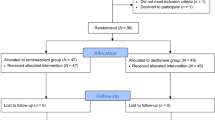Abstract.
This study was conducted to determine the efficacy of procainamide therapy for rapid rate control of postoperative junctional tachycardia (JT). Postoperative JT is one of the most difficult forms of tachycardia to manage. Reported success with a variety of treatments of JT in infants and children has been inconsistent and limited. Rate control using procainamide was achieved in 17 children having rapid JT (heart rate >200 beats/min) between 1986 and 1997. In the first 5 patients (protocol A), following a loading dose of 3 mg/kg over 20 minutes, a continuous procainamide infusion was initiated at a rate of 20 μg/kg/min. The infusion dose was increased in 10 μg/kg steps every 30 minutes to 40–120 μg/kg/min until the heart rate decreased below the target rate of 180 beats/min. In the other 12 patients (protocol B), after a higher loading dose of 10 mg/kg the infusion rate was increased every 10–15 minutes until the heart rate decreased below the target rate of 180 beats/min. Procainamide decreased JT rates in all patients but the response was significantly faster in protocol B. In the patients treated with protocol A, pretreatment JT rates ranged from 203 to 240 (213 ± 17) beats/min and decreased to 195 ± 10 beats/min at 2 hours (p= ns), 186 ± 8.8 at 4 hours (p < 0.02), and 179 ± 8 at 6 hour postinitiation of PA. In protocol B, pretreatment JT rates ranged from 201 to 240 (218 ± 17) beats/min and decreased to 183 ± 20 beats/min at 2 hours (p < 0.001) and 171 ± 12 at 4 hours after starting the procainamide therapy. The mean duration to decrease JT rates below the target rate of 180 beats/min was 3.2 ± 1.1 hours in protocol B compared to 6.4 ± 3.8 hours in protocol A (p < 0.02). Eight of 12 patients in protocol B achieved rate control below the target rate of 180 beats/min within 4 hours despite remaining on significant inotropic support. The procainamide infusion rates to maintain heart rates below 180 beats/min were 40–120 (68.4 ± 22.1) μg/kg/min. No proarrhythmia, bradycardia, or significant hypotension was observed. In this series procainamide provided safe, effective, and rapid rate control of JT occurring in the immediate postoperative period.
Similar content being viewed by others
Author information
Authors and Affiliations
Rights and permissions
About this article
Cite this article
Mandapati, R., Byrum, C., Kavey, R. et al. Procainamide for Rate Control of Postsurgical Junctional Tachycardia. Pediatr Cardiol 21, 123–128 (2000). https://doi.org/10.1007/s002469910018
Published:
Issue Date:
DOI: https://doi.org/10.1007/s002469910018




